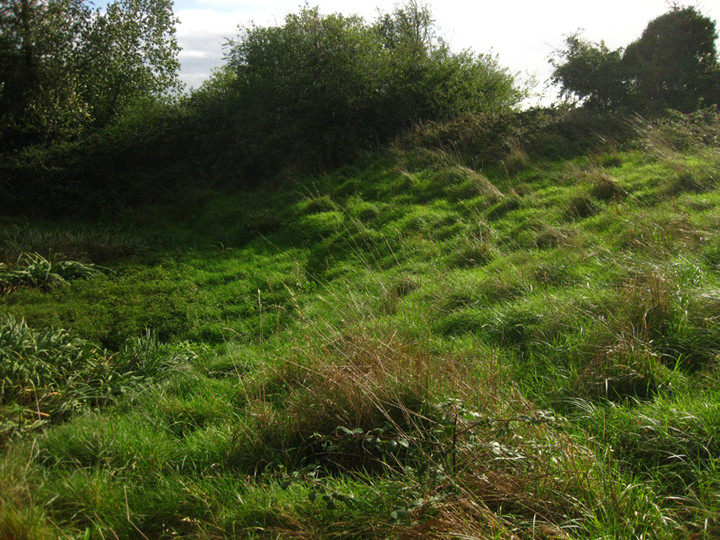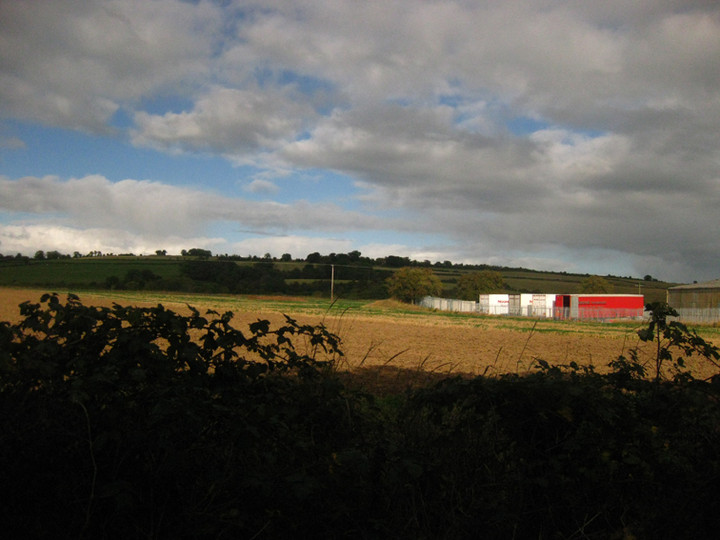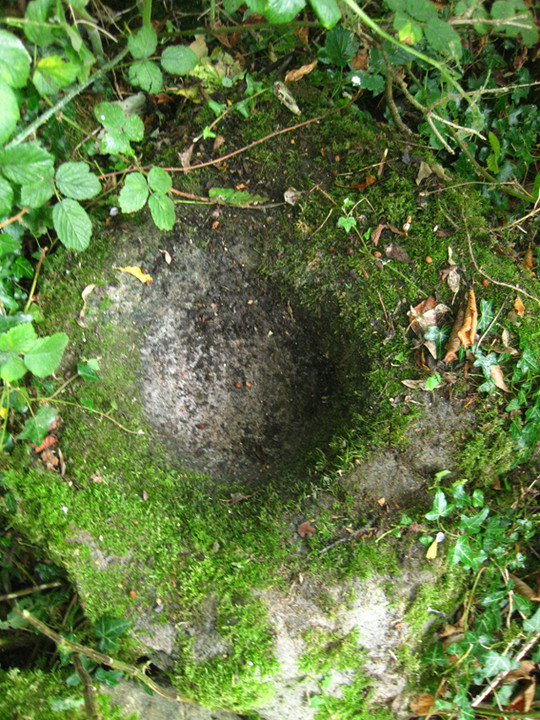
The bank on the western arc of the enclosure rises to a height of over 3 metres.

The bank on the western arc of the enclosure rises to a height of over 3 metres.


The tree at the centre of the shot marks the spot where this destroyed henge was. The henge was excavated shortly before being destroyed to make way for the industrial complex on the site.

The curve of the north-east arc of the henge is visible in the centre of this shot.


The southern most ‘sundial’. These carvings continue to erode.


Zoomed shot of some of the remains of the great circle.





From the Arch. Inventory of Co. Louth:
This circular hilltop cairn, 21m in diameter and over 4m in height, contains the remains of a megalithic structure 3.5m long, in the SW quadrant. It is open to the SW and narrows from 1m wide to 0.5m at the rear. Three lintels are in position; the rear 0.7m of the structure is corbelled. The remains would seem to be those of a passage-tomb of uncertain design. Near the centre of the cairn are the remains of a drystone-walled circular structure, 3.3m in diameter, with an entrance passage opening to the SE, which may have been built by Lord Clermont. (CLAJ 1941, 77-9; Herity 1974, 232).
You can drive right up to this mountaintop cairn, though I suggest you wait until the cloud clears, unlike us who drove up in maybe 10 metre visibility and a force 10 gale. There is a huge mast up here, hence the road, and the howls as the wind blew through it added to an already spooky atmosphere.
The cairn, said to be a passage grave (see archaeology.ie entry) is about 3 metres high. Much of it is now grass covered, though there are patches where its true nature is still visible. There are quite a few larger stones around, though I couldn’t make head nor tail of these, battling as I was with the driving mist of low cloud.
I would say that the views from here are spectacular but we couldn’t see to confirm that. As it’s a driveable climb, I may re-visit here some day to check.

Proleek, like quite a few portal tombs, seems to be a different monument depending on what angle you view it from. The supporting wall that helps support the backstone/sidestone, and thereby keeps the capstone in situ, is very evident here.


An impressive specimen of a wedge tomb, overshadowed by the tilting madness of its near neighbour portal tomb.

The basin is at the very top of the stone, almost hidden by the overhanging ivy.

The stone is in the hedge at the side of a lane.

The basin of this large stone is about 35cms in diameter. The water was putrid, a cure for many skin complaints I’ve no doubt.

Some structural stones on the southern side of the cairn.


The cairn/passage grave on Black Mountain in Ravensdale Park.

The flattened top of the cairn/passage grave on the summit of Black Mountain.

Capstone of the second cist, away from the perimeter of the cairn. There may be a third cist.



Cist on the north perimeter, thought to have used original kerbstones when it was inserted into the cairn.

Cashel Man has had the weight of the world on his shoulders, quite literally, for 4,000 years.
Compressed by the peat that has preserved his remains, he looks like a squashed, dark leather holdall.
Apart, that is, from one forlorn arm that stretches out and upward and tells us something of the deliberate and extremely violent death that he suffered 500 years before Tutankhamen was born.
Cashel Man is now being studied at the National Museum of Ireland’s research base in Collins Barracks, Dublin. He was discovered in 2011 by a bog worker in Cashel bog in County Laois.
When the remains are brought out of the freezer, it is hard to tell that this was ever a human being.
New book on the excavations at Lismullin.
I’d been to Carbury Hill before and not visited the barrows. The site is really a barrow cemetery – I counted four, but there may be more under the gorse as the hill drops away to the west.
The main barrow is huge and its ditch hasn’t silted up too badly over the years. Indeed, it’s almost 2 metres deep in places. The diameter is about 30 metres and it has two satellite barrows within another 30 metres of it. There’s also another small mound/barrow about 120 metres to the south with the ubiquitous trig point plonked on it.
From the main barrow, there would be views all around had the gorse not taken hold so vigoursly.
I’d spent an hour looking for this stone about three years back. After that failed visit, Tom Fourwinds stumbled upon it and I’d been meaning to visit for quite a while.
This was our first site visit of the day and we were delighted to see that it had a small black cat/kitten as a sentinel. The basin on this one is huge, maybe a foot across. It’s cemented into the boundary wall, above the small tributary of the Liffey that flows past the front garden in suburban Clane.
From archaeology.ie:
A circular hollow (diam. 0.4m; D 0.25m) in a natural rock outcrop is known locally as the ‘Wart Well’. Traditionally, the ‘well’ appeared after St Brigid’s horse left a hoof-mark in the stone. For a cure, it must be visited three times; a pin is left at the first visit and at the third visit the pins and warts will have disappeared.
The friendly landowner convinced me not to go out to this site and it is completely overgrown. It’s marked as a holy well on the map but as a bullaun stone on the National Monuments Database.
The lady said that there are some Americans interested in the site and that they are going to do some work there in the near future, tidying up the site and freeing up access. I asked could I come back next summer and she said sure.
(I’ve posted this here as the folklore is worth relating)
Two small bullauns in a field that has an old burial ground beside it. There’s a small structure here too that may the site of an old family burial plot. For the second time today we were met by a very friendly and knowledgeable landowner as we were about to take our leave.
He said that he had the whole history of the vicinity and I asked had he family in the burial plot. He said no, that he was a catholic and I said so the site is protestant. He said yes. I explained that I was interested in stuff before all that and that the bullauns were maybe from that era. He said aye, the druids and the pishogues (pisógs in Irish) and that he wouldn’t touch the stones. A lovely man again – we’d still be there had we not made our excuses.
When I first knocked at the door of the house and asked for the bullaun stone of the lady of the house, I was met with curiosity and puzzlement. Then I mentioned the wart stone and she pointed over my shoulder and laughed. Just then, the man of the house came out (they were just finishing their dinner – taken at lunchtime in many houses in rural Ireland) and accompanied me over to the stone. He had lots of tales of the many people who come here from all over Ireland, and the world, for the cure.
He related a story of a neighbour’s boy, a three-year-old that had been to the Mater hospital “up in Dublin” with warts that were covering his hands. The doctors did their best with surgery and medicine but still the warts grew back. Somebody told the parents of the stone and they brought the boy here, washed his hands in the water that collects in it (I asked if he ever puts water in the stone and he said no, the water is only ever what collects naturally) and the warts went, never to come back.
He had other tales of a burial chamber on his land, water divination and the hanging of a priest on the road at the front of his property. He also told me that the structure beside the stone, and the little enclosure that the stone rests on, were built around the stone and that he would never dream of moving it. A very friendly and accommodating man.
We asked for permission to visit the rock at the small cottage on the right hand side of the lane as you head down. We were met with suspicion and hostility and told that no, we couldn’t visit the site. I asked why was that and the old farmer told of how many people had come and damaged the fences and crops around the stone. The field that you would have to cross is too wet to be a tillage field so half of his argument was bull’. I explained that the people who had pissed him off previously maybe didn’t have the same respect or reverence for the site and that me and my four year old daughter would do our best to leave his place exactly as we found it. I pressed him a bit, and felt then and feel now that if I had pushed a little further, he’d have relented, but I wasn’t up for the argument, annoyed at his small-mindedness and suspicion. I’m not in Donegal that often and will probably never come back this way again. Shame.

Both stones, lit up with some flash and cleaned out a bit.


The Nine-hole stone a little over 6 years ago.
Known elsewhere as Meelaghans, this is actually in Kileenmore townland. When we eventually managed to get to the small copse of trees where the stone is, I was hugely disappointed to find that it was no longer there. First thoughts were that either it had been dug up and carted off (unlikely, but you never know) or that it was buried under the nearby pile of manure.
We moved over to the other copse 100 metres south and found the single bullaun. The basin is set into an earthfast stone about 3 metres long and is quite substantial. I was still flabbergasted by the absence of the other stone and I didn’t give this too much time.
We headed back to the nine-hole stone copse. I just couldn’t believe that it wasn’t there any longer. Rooting around I noticed a curve in the soil that looked like the lip of a bowl. No way – could it be buried? I knew that the stone was about a foot below ground level so I got a stick and started digging and sure enough, a bowl/basin re-emerged. So this is how bullauns get lost – neglected and forgotten about, the bowls fill up with soil and detritus and eventually they get grassed over.
Paulie attacked the digging with vigour, re-finding 3 of the large basins. I just hadn’t the heart, thinking that the landowner doesn’t give a rats and that the stone will get covered over again. I was annoyed and angry and just wanted to get out of there, curious bullocks adding to the tension I felt. I don’t know what to do about this situation – petition for the stone to be brought into state care? Not a very likely proposition at present.

Very disappointed at the lack of care for this important bullaun stone, this is how we left it.




